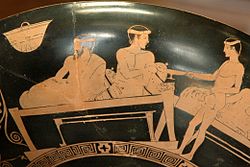Cup-bearer
Cup-bearers are mentioned further in 1 Kings 10:5, and 2 Chronicles 9:4, where they, among other evidences of royal splendor, are stated to have impressed the Queen of Sheba with Solomon's glory.The count headed the scancia (singular scancium), which in English would be called cellars or buttery and in French échansonnerie, which is a cognate to the Latinized Gothic term used in Spain.The count would have poured the king's wine or drink personally while the other cup-bearers served other distinguished guests at the royal table.The office of butler or cup-bearer (pincerna in Medieval Latin) in Anglo-Saxon England was occupied by aristocrats who were in charge of drinks at royal feasts.The cup-bearer (Polish: cześnik, Lithuanian: taurininkas) was a court office in Poland and Lithuania until the end of the 13th century.According to the district office hierarchy in 1768, the position in the Crown was over Łowczy and under Podstoli; In the Grand Duchy of Lithuania over Horodniczy (Gorodnyčius) and under Podczaszy (Pataurininkis).

royal courtsRosetta StoneKanephorosPtolemaic DecreeDecree of CanopusSargon of Akkad23rd century BCNehemiahArtaxerxes I of PersiaNational Library of PortugalGenesisbutlerKing ArtaxerxesQueen of ShebaSolomonGreek mythologyGreek godsMount OlympusnectarambrosiaGanymedeHeraclesRoman godsJuventasPinkernespalatineKing of BohemiaHoly Roman EmpireCount of AlthannEmperorDish-bearers and butlers in Anglo-Saxon EnglandMedieval LatinAnglo-Saxon EnglandthegnsealdormenThe Winter's TaleShakespeareTheobald WalterMaster of the CupbearersPolishLithuanianPolandLithuaniaCrown of PolandGrand Duchy of LithuaniaPolish–Lithuanian Commonwealththe CrownŁowczyPodstoliPodczaszyBartenderFood tasterPaharnicSommelierXenophonHellenicaBook of NehemiahHerodotusHistoriesCyropaediaJosephusAntiquities of the JewsBook of TobitInternational Standard Bible Encyclopedia